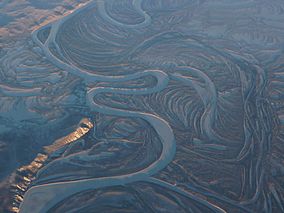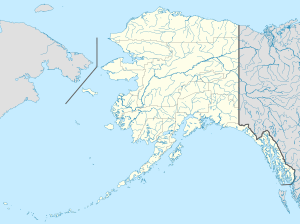Koyukuk National Wildlife Refuge facts for kids
Quick facts for kids Koyukuk National Wildlife Refuge |
|
|---|---|
|
IUCN Category IV (Habitat/Species Management Area)
|
|

Aerial view of the lower Koyukuk River floodplain
|
|
| Location | Alaska, United States |
| Nearest city | Galena, Alaska |
| Area | 3,500,000 acres (14,000 km2) |
| Established | 1980 |
| Governing body | U.S. Fish and Wildlife Service |
| Website | Koyukuk NWR |
The Koyukuk National Wildlife Refuge is a huge protected area in Alaska. It covers about 3.5 million acres (14,000 km²)! This special place is found in the flat, watery land around the Koyukuk River. It stretches from the big Yukon River all the way to the Purcell Mountains and the start of the Brooks Range.
This area is full of wetlands, which are like marshy, wet lands. It's home to many animals, including fish, waterfowl (like ducks and geese), beavers, and Alaskan moose. In the wooded lowlands, you can find two types of fox, different kinds of bears, wolf packs, Canadian lynx, and martens.
Contents
Protecting Alaska's Wildlife and Wetlands
The Koyukuk National Wildlife Refuge was created in 1980. Its main job is to protect the amazing wildlife and their homes in this part of Alaska. This includes the important wetlands and forests.
The Innoko Refuge Connection
A part of the Innoko National Wildlife Refuge is also managed with Koyukuk. This section is called the Northern Unit, or Kaiyuh Flats. It's about 750,000 acres (3,000 km²) and has lots of wetlands. This area is super important for many birds and fish.
Fish and Aquatic Life
The rivers and streams in the refuge complex are full of fish. You can find three types of salmon here. There are also Arctic grayling, sheefish, and many other kinds of fish. Some northern pike that live in the shallow lakes of the Northern Innoko Refuge can grow to be very large!
Birds and Their Breeding Grounds
The wetlands at Koyukuk Refuge are perfect for breeding waterfowl. These birds eat water plants and lots of protein-rich bugs. Young birds grow up fast during the short, warm summer. Then, they get ready for their long migration in the fall.
Waterfowl Reproduction and Growth
During one nesting season, as many as 100,000 ducks can hatch and grow up on the refuge lands. Many other birds, like migratory songbirds and raptors (birds of prey), also use the Koyukuk Refuge. They come here to breed and raise their young because there is so much food and good habitat.
Moose Habitat and Population
The Three-Day Slough area within the Koyukuk Refuge is a special place. It's part of the 400,000-acre (1,600 km²) Koyukuk Wilderness. This area has some of the best habitat for Alaska moose in all of Alaska.
Moose Counts and Conservation
Sometimes, this region has had more than 10 moose per square mile! Recent counts show that some areas still have about five or more moose per square mile. Counting these large animals is a team effort. The U.S. Fish and Wildlife Service works with the Alaska Department of Fish and Game to keep track of the moose.
Caribou and Other Mammals
Caribou are also found here. The Western Arctic Herd, which has over 450,000 caribou, sometimes moves into the northern parts of the refuge in winter. They search for lichens, which are like mossy plants, hidden under the snow.
Resident Caribou and Predators
The Koyukuk Refuge also has a smaller group of caribou that live there all the time. This group is called the Galena Mountain Herd, and it has about 300 caribou. Besides caribou, you can find wolf packs, Canadian lynx, and other furbearing animals. Black bears and grizzly bears also live on the refuge year-round.


